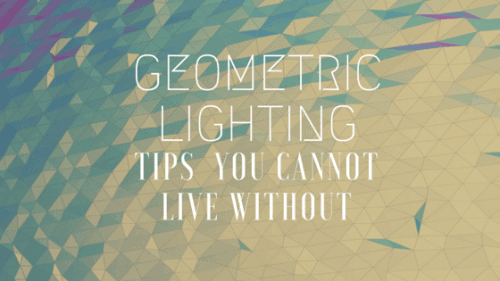
Who knew primary school math will come back to haunt you 20 years later? Don’t worry, we aren’t doing any math here! In fact, we’ll be using art and design to tackle a math problem. Geometric light fixtures made its way into the hearts of designers not too long ago: we see a growing number of home and cafe owners choosing to incorporate it into their interiors. Adding it into your space gives it an immediate air of sophistication and modernity. They are so well-loved because of their clean and minimalist characteristics making it simple to work with.
Hold your horses! Don’t go crazy mixing and matching interiors with geometric lights! Just like math, there are some sums that just won’t work out. We’re here to save your grades with these cheat notes to score in the geometric light fixture test.
ONE :: Opposites Attract
This is the go-to rule for design novices: while it may not work for everything, it works well for most things. In the case of geometric lights, it is easy for the room to take on the stiffness exuded by the light’s straight-cut edges, hence it is important to include some curved edges in your design. You can also use soft furnishing to complement the hard lines, thus creating balance in the environment.
The picture on the left shows a room adorned with a black framed geometric light fixture. The straight lines on the light is juxtaposed against the curved white edges of the chairs. The circular fruit bowl on the table helps to neutralize the sharpness. On the right, the curved geometric light fixture does well in striking a balance between straight and curved lines. It is further accentuated by the wooden chair against the soft navy cushions and the bench decorated with grey pillows. The perfect execution of the ‘opposites attract’ rule in this picture entitles it a 10/10.
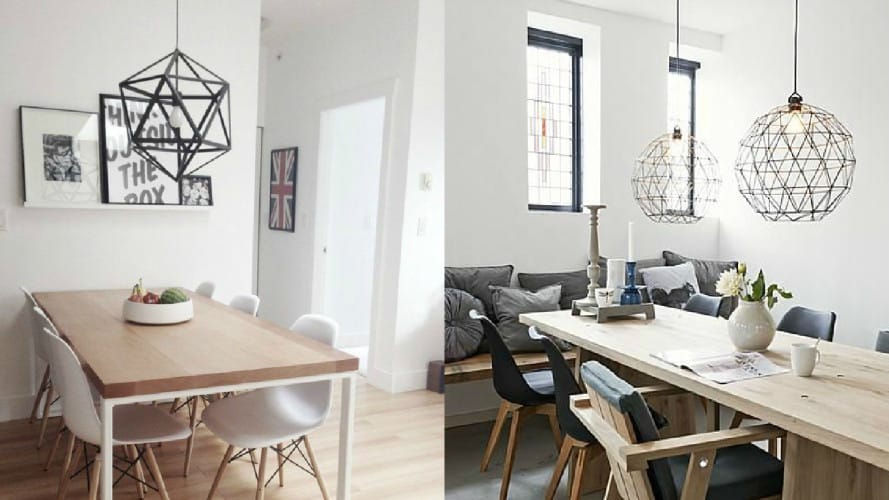
TWO :: Placement
Believe it or not, when styled right, geometric lights can appear in all parts of the house. Decor aside, how do you ensure its seamless incorporation into the environment? Apart from its size, you have to ask yourself: ‘What type of light fixture is it? A pendant light? A standing light?’ For pendent geometric lights, it is safe to install them in open areas such as the living room, over the kitchen island, and dining areas. The openness of the space makes sure the delicate geometric lights is the focus: this will be elaborated in a later point. The height of the pendant lamp is also an aspect to take note of: for smaller and flatter geometric lights, lengthening its height is the way to go.
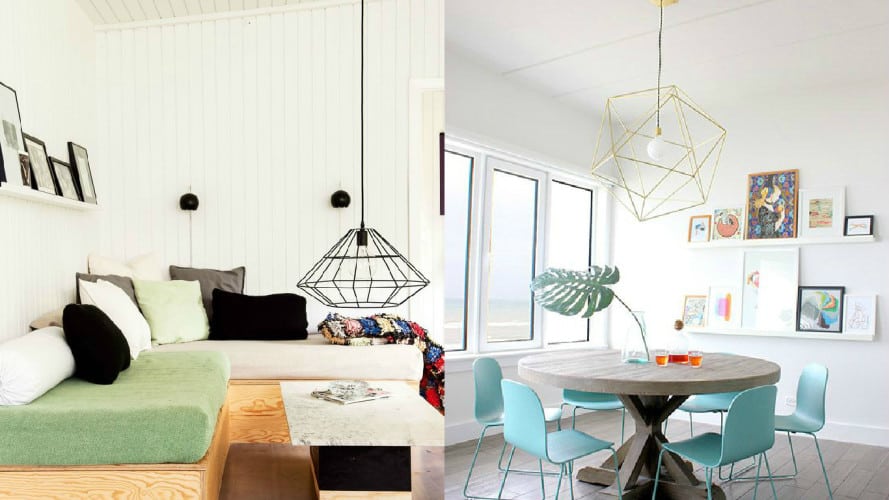
For standing geometric lamps, height is key for making your setup work. Due to the intricate and hollow nature of geometric lamps, it is sinful to set it against other fuller ornaments as it would draw attention away from the lamp. Hence, it is ideal for the lamp to rest on a clear surface and or be placed with ornaments that are shorter in height so there will be minimal obstruction. Common areas are bedside tables, dressing tables, and as a table piece in a cafe. Anyway, who’s going to spend money on something so pretty and then hide it away from the world? That’s being selfish and Screed’s readers are definitely not selfish (prove to us that you aren’t by sharing this article)!
THREE :: Symmetry
Oh no! Math again? Symmetry has been proven to be pleasing to the eye and it is totally not an OCD thing! The element of symmetry is especially stark when one opts for a regular polygonal geometric light fixture – take some time to digest that phrase, maybe even Googling what a ‘regular polygon’ is. Oh, the primary school syllabus! Maintaining symmetry helps you to control the balance of the room: Balance is crucial as you don’t want your visitors to enter your space and feel that something is off! What’s worse is not knowing what is off! Oh the torture. Of course, not everything has to be Wes Anderson’s standard: there are ways to create an illusion of centeredness.
The sure-win way would be to fix your geometric light fixture in the middle of a table. As seen in the picture of the left, symmetry is created when the light fixture is positioned above the table. However, the picture in the right shows the light fixture positioned off the table. Are you feeling any discomfort yet? Yes? No? You shouldn’t as the symmetry comes from the windows at the back. #mindblown
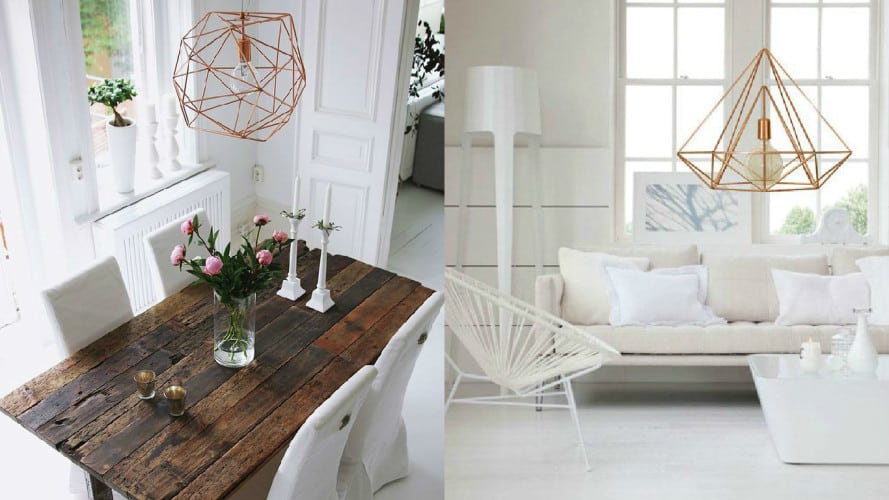
FOUR :: Simplicity of The Room
Remember joking about someone being so thin that one day that person might disappear? Well, it is not entire false. Gasp! The intricate nature of the geometric lights, no matter how pretty, is constantly at mercy of being swallow by the commotion in the environment, thus disappearing into the background. Following an earlier point: open spaces are great for pendant geometric light fixtures because it has the least potential for clutter.
The trick is to keep your walls clean and your colour palette neutral. Minimize pictures or shelving on the walls. If you need to, keep them as neutral as possible. However, sticking with a neutral colour palette is not a hard-and-fast rule: keep about 70% of your space neutral and go wild with the other 30%. Simply following this tip will help you achieve a modern themed space! Tell who doesn’t like a touch of minimalism in their life? Ain’t it amazing to come home to a clear and open space?
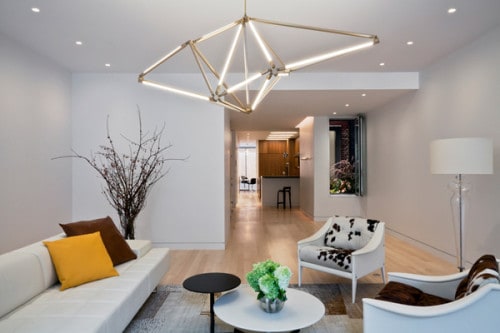 FIVE :: Complementing Features
FIVE :: Complementing Features
While you want your geometric lights to stand out, you also want it to be in harmony with the rest of the interior decor. Some might point out that this goes directly against the point on opposites attract. Here’s what we have to say (get ready for your brain to explode): It is following the rule of opposites attract to incorporate opposite and complementary elements in a design. This is too meta!
Complementary designs are not limited to using the same colour or the same pattern. Check out the follow rooms to see how they play this complementary game. On the left, we see a completely white room with a copper geometric light fixture. Take a moment to understand why this arrangement works: The thin, straight lines on the wired chair seen at the side neatly pulls the light fixture into the picture because they share a common form. While on the right, we see a geometric shade complemented by the criss-crossing triangular legs of the table below! Mind blown yet?
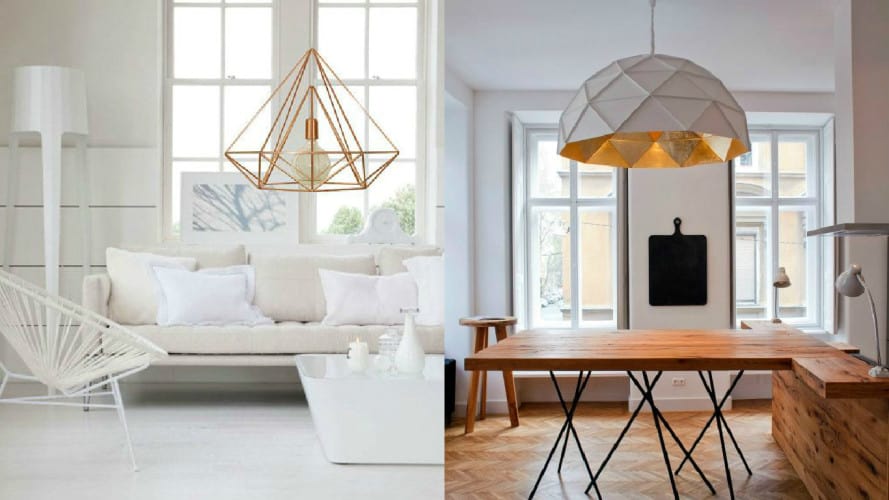
SIX :: Shadows
First math, now science?! It is common sense that when light is being obstructed, a shadow will be cast in the background. It goes for these geometric light fixtures as well. If your light fixture is hollow, a shadow of the geometrical skeleton might appear on your walls. While this is some cool science we have here, some people might not enjoy the patterned shadow effect.
What you can do is to switch your light bulb for one of a lower wattage. This will result in a dimmer light and subsequently, a less pronounced shadow. Or you can also choose to distance your light fixture from any flat surfaces so the light would have dispersed before a shadow can be formed.
Here at Screed, we think it is pretty cool to have a patterned shadow on our walls. It makes the plain walls more exciting, don’t you think? A few weeks back we shared a DIY by Emmmy Lizzzy on how one can make a shadow chandelier. That’s some pretty rad stuff. You missed it? That must suck! ‘Like’ us on FaceBook so you can keep up with the cool crowd (that’s us!).
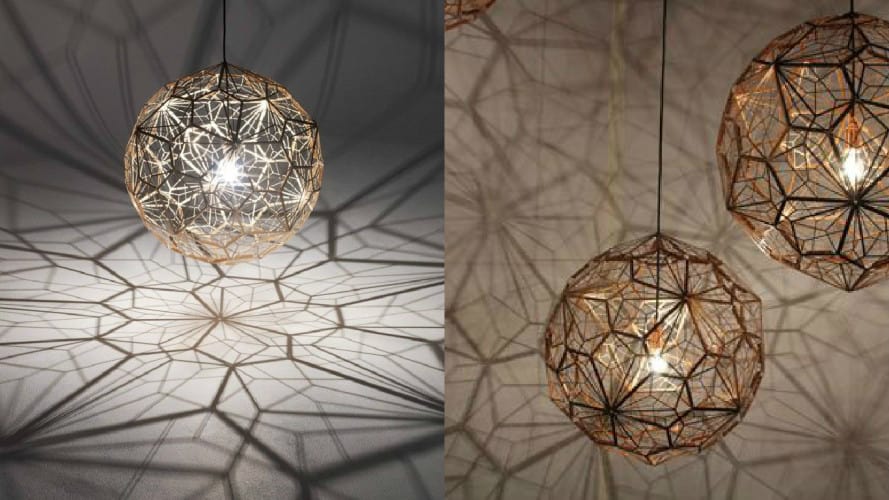
A final note before this class is dismissed! We hope these pointers have been useful in helping you decide that you can do with your geometric light fixture. Or maybe you’re someone thinking of getting one for your space? Have you checked out our KARIN Triangular Cage Lamp or the KLAS Pyramid Cage Lamp? What are you waiting for? Check out our range of modern style lights! We promise our low prices will blow your mind.
On that note, class, you’re dismissed!



